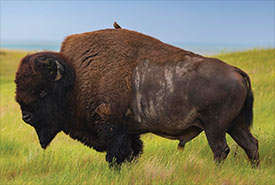Return of the wild

Bison at OMB, SK (Photo by Jason Bantle)
Bringing species back to places where they have been lost, such as the reintroduction of plains bison to NCC’s Old Man on His Back Prairie and Heritage Conservation Area, is good for animals, plants and people.
By Susan Peters, writer and editor
Darkness had fallen by the time the convoy reached the Nature Conservancy of Canada’s (NCC’s) Old Man on His Back Prairie and Heritage Conservation Area (OMB). Starting from the early morning, the trucks towing trailers full of plains bison (commonly referred to as buffalo) had driven south, leaving behind trees dusted with snow in Elk Island National Park, east of Edmonton, to reach the clear skies of southern Saskatchewan. Neighbours and TV crews were waiting. They watched in the headlights as the trailer doors opened: the yearlings jumped off, then trotted to the far end of the paddock. Not wanting to spook the animals, the humans, including Peter and Sharon Butala, former owners of the ranch-turned-conservation-area, silently caught each other’s eyes. For the first time in a century, the bison had returned to this prairie.
There have been some amazing success stories where endangered species started using restored habitats very quickly. But sometimes the species that we need to protect simply can’t return without help. The UN Decade on Ecosystem Restoration is an opportunity to rebuild some of Canada’s most threatened habitats and bring back their wildlife.
Like the return of plains bison to OMB in 2003, projects that aim to return plants and animals to places where they have been lost — whether by reintroducing a species or supplementing existing populations — are happening across the country. The consequences can have enormous ecological and cultural significance.
Reshaping the land
As you rumble across the cattle guard to Old Man on His Back, the scent of sage might fill the air, while the sound of songbirds becomes more pronounced, like the warble of the endangered chestnut-collared longspur.
“The variety of plant and animal species, and the number of birds you see, increases dramatically as you drive through the gate, moving from cultivated land to native prairie,” says Jennifer McKillop, regional vice-president for NCC’s Saskatchewan Region. Bison evolved over millennia, in tandem with the prairie grasses with their enormous roots that can stretch down 4.5 metres to store energy over the winter or perhaps avoid droughts. But the buffalo now on the property can be hard to spot on the 5,000 hectares (12,355 acres) of dry, treeless hills, unless they choose to be visible.
While they may at times be invisible to human visitors, the roughly 100 bison here shape the land, improving the health and diversity of the prairie. That includes the wool they scrape off on the large glacial erratics, which allow the woolly animals to shed their winter coat and scratch an itch — ah, there’s the spot. In spring, songbirds dart to grab hair to line their nests, as it helps regulate the temperature for their featherless hatchlings. The bison also love to roll in the dirt, creating wallows. In spring, the shallow craters fill with water, and in the summer, as they dry, the bare patches become habitat for rare plants. OMB is part of the mixed grassland ecoregion, a mosaic of short and mid-length grasses. In Saskatchewan, less than 20 per cent of native prairie grasslands remain. Temperate grasslands like this are one of the most endangered ecosystems in the world. Twenty years ago, Peter (who has since passed away) and Sharon decided to gift 422 hectares (1,043 acres) of their property to NCC, with the provision that it would remain grassland and the bison would return.
This is an excerpt of a story that first appeared in the Spring 2021 issue of the Nature Conservancy of Canada Magazine. Donors who contribute at least $25 or more per year will receive the magazine. Click here to donate today and start receiving the magazine.



